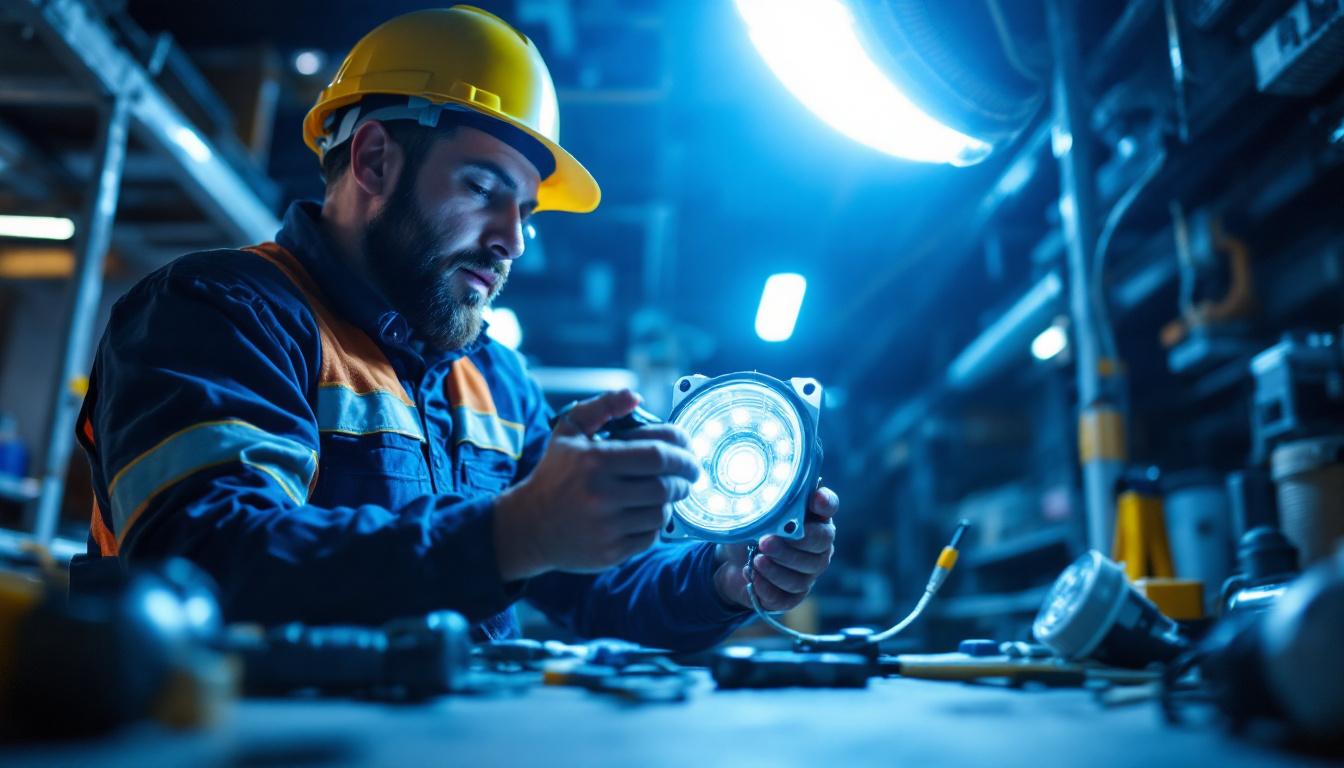
Understanding the intricacies of lighting systems is crucial for any lighting contractor. Among the many components that play a vital role in these systems, the light ballast stands out as a key element. This article delves into the definition, function, and types of light ballasts, providing valuable insights for professionals in the field.
A light ballast is an electrical device that regulates the current to fluorescent and HID (high-intensity discharge) lamps. It serves multiple functions, including starting the lamp and providing the necessary voltage to maintain its operation. Without a ballast, these types of lights would not function properly, leading to flickering or complete failure.
Ballasts are essential for ensuring that the lamp operates efficiently and safely. They prevent the lamp from drawing too much current, which can lead to overheating and potential damage. Understanding the role of a ballast is fundamental for lighting contractors who aim to deliver high-quality installations. Furthermore, the choice of ballast can significantly impact the overall performance and longevity of the lighting system, making it a critical consideration in any lighting design project.
In addition to their functional roles, ballasts also play a part in energy conservation. With the increasing emphasis on sustainability and energy efficiency, selecting the right ballast can contribute to lower energy consumption and reduced operational costs. This not only benefits the environment but also enhances the return on investment for businesses and homeowners alike.
There are primarily two types of ballasts: magnetic and electronic. Each type has its own set of characteristics and applications, making it crucial for contractors to understand the differences.
Magnetic ballasts are the traditional type, utilizing electromagnetic coils to regulate current. They are generally larger and heavier than their electronic counterparts. While they are known for their durability, magnetic ballasts can be less energy-efficient and may produce a humming noise during operation.
These ballasts are often used in older lighting systems and can be found in various commercial and industrial applications. Contractors should be aware that while they may require less upfront investment, they can lead to higher energy costs over time. Additionally, magnetic ballasts may not be compatible with newer lamp technologies, which could limit options for upgrades or replacements in the future.
Electronic ballasts are more modern and utilize electronic circuitry to control the current. They are typically smaller, lighter, and more energy-efficient than magnetic ballasts. One of the significant advantages of electronic ballasts is their ability to provide a flicker-free operation, enhancing the quality of light and reducing eye strain.
Additionally, electronic ballasts can often support a wider range of lamp types and are more adaptable to varying lighting needs. For contractors, this means greater flexibility in design and installation, making them a popular choice in contemporary lighting projects. Furthermore, many electronic ballasts come equipped with features such as dimming capabilities and advanced control systems, allowing for more sophisticated lighting designs that can respond to changing conditions and user preferences.
As technology continues to evolve, electronic ballasts are becoming increasingly integrated with smart lighting systems, enabling remote control and automation. This trend not only enhances convenience but also allows for more precise energy management, further driving down costs and improving efficiency in both residential and commercial settings.
Selecting the appropriate ballast is critical for the overall performance of a lighting system. The right choice can enhance energy efficiency, improve lamp lifespan, and ensure optimal lighting quality. Conversely, an incorrect selection can lead to operational issues and increased maintenance costs.
Contractors should consider several factors when choosing a ballast, including the type of lamp, the intended application, and energy efficiency ratings. Understanding these elements can help contractors make informed decisions that align with their clients’ needs and expectations. Moreover, the growing emphasis on sustainability and energy conservation in recent years has made the selection of the right ballast even more crucial, as it plays a significant role in reducing the carbon footprint of lighting systems.
When selecting a ballast, several key factors should be taken into account:
Different lamps require different types of ballasts. For instance, fluorescent lamps need specific ballasts designed for their operation, while HID lamps require ballasts that can handle higher voltages. Ensuring compatibility is paramount to avoid performance issues and ensure safety. Additionally, the rise of LED technology has introduced new ballast requirements, as some LED fixtures are designed to operate with existing ballasts while others are direct-wired. This evolving landscape necessitates that contractors stay informed about the latest advancements in lighting technology to make the best choices for their projects.
Energy-efficient ballasts can significantly reduce electricity consumption, leading to lower utility bills. Many contractors are now opting for electronic ballasts due to their superior efficiency ratings. Additionally, energy-efficient systems may qualify for rebates or incentives, providing further financial benefits. As energy costs continue to rise, the long-term savings associated with energy-efficient ballasts can be a compelling selling point for clients. Furthermore, the integration of smart technology with ballasts allows for advanced features such as dimming and occupancy sensing, which can further enhance energy savings and improve user experience.
The specific application of the lighting system also influences ballast selection. For example, a commercial setting may require ballasts that can handle frequent on-off cycling, while residential applications may prioritize quiet operation. Understanding the unique requirements of each project is essential for optimal performance. In environments such as warehouses or manufacturing facilities, where lighting is often subject to harsh conditions, selecting robust and durable ballasts can prevent premature failures and ensure consistent operation. Additionally, considering the aesthetic aspects of lighting in spaces such as retail or hospitality can guide the choice of ballasts that not only perform well but also complement the overall design vision.
Proper installation of light ballasts is crucial for ensuring the longevity and efficiency of the lighting system. Following best practices can help contractors avoid common pitfalls and deliver high-quality installations.
Safety should always be the top priority during installation. Contractors must ensure that the power is turned off before beginning any work. Additionally, using appropriate personal protective equipment (PPE) can help mitigate risks associated with electrical work.
Correct wiring is essential for the proper functioning of the ballast and the overall lighting system. Contractors should refer to the manufacturer’s instructions for wiring diagrams and specifications. Ensuring that connections are secure and correctly insulated can prevent electrical failures and enhance safety.
After installation, it is crucial to test the system to verify that everything is functioning as intended. This includes checking for flickering, ensuring that the lamps start correctly, and confirming that the ballast is operating within its specified parameters. A thorough testing process can help identify any issues before the system is handed over to the client.
Regular maintenance of lighting systems, including ballasts, is vital for ensuring long-term reliability and performance. Understanding common issues and their solutions can help contractors provide better service to their clients.
Some common problems associated with ballasts include flickering lights, buzzing noises, and lamps not starting. These issues can often be traced back to faulty ballasts or incorrect wiring. Identifying these problems early can save time and costs associated with extensive repairs.
Knowing when to replace a ballast is essential for maintaining system efficiency. If a ballast is consistently causing issues or if it is more than a few years old, it may be time for a replacement. Upgrading to a more energy-efficient model can also provide long-term benefits.
Regular inspections and cleaning can help extend the life of ballasts and lamps. Dust and debris can accumulate over time, affecting performance. Contractors should encourage their clients to schedule routine maintenance checks to ensure that their lighting systems remain in optimal condition.
The lighting industry is constantly evolving, and advancements in ballast technology are no exception. Staying informed about these trends can position contractors at the forefront of the market.
Smart ballasts are emerging as a popular trend, integrating with building management systems and allowing for greater control over lighting environments. These systems can adjust lighting based on occupancy, time of day, or natural light availability, enhancing energy efficiency and user comfort.
As LED technology continues to gain traction, the compatibility of ballasts with LED lamps is becoming increasingly important. Many manufacturers are now producing ballasts specifically designed for LED applications, ensuring optimal performance and energy savings.
Regulatory standards regarding energy efficiency are continually evolving. Contractors must stay abreast of these changes to ensure compliance and to take advantage of any incentives available for using energy-efficient products. Understanding these regulations can help contractors provide better solutions to their clients.
In the realm of lighting installation, understanding the role and function of light ballasts is essential for contractors. From selecting the right type to ensuring proper installation and maintenance, a thorough knowledge of ballasts can significantly impact the quality and efficiency of lighting systems.
As technology continues to advance, staying informed about new trends and best practices will empower contractors to deliver superior service and solutions. By prioritizing education and adaptation, lighting professionals can ensure they remain competitive in an ever-evolving industry.
Ultimately, the right approach to light ballasts can enhance not only the performance of lighting systems but also the satisfaction of clients, paving the way for successful projects and long-term relationships.
Ready to elevate your lighting projects with the highest quality ballasts? Look no further than LumenWholesale, where we offer an extensive selection of spec-grade lighting products at unbeatable wholesale prices. Say goodbye to inflated markups and hello to superior performance and reliability for all your lighting needs. With our commitment to quality, affordability, and convenience, you’ll enjoy hassle-free bulk buying with free shipping. Don’t compromise on your lighting installations—choose LumenWholesale for the best value in wholesale lighting. Explore our products now and experience the difference.

Discover the key insights into motion lights outdoor installations that clients expect lighting contractors to master.

Discover how solar-powered driveway markers are revolutionizing lighting installations by enhancing profitability and sustainability.

Discover the secrets to maximizing efficiency with Panel Led 2X2 lighting solutions.

Discover how lighting contractors can enhance their projects and boost client satisfaction with the innovative use of LED wall lamps for outdoor spaces.